As an experienced affiliate marketer, I’ve taken my fair share of online courses, always on the lookout for the next big thing that promises to boost my earnings and streamline my strategies.
When I first heard about “Making Sense of Affiliate Marketing” by Michelle Schroeder-Gardner, I was intrigued. Michelle’s success story is well-known in the blogging community, and her course seemed to be a comprehensive guide to affiliate marketing. However, after diving into the material, I found myself questioning whether the course truly lived up to the hype.
In this review, I’ll share my honest experience with “Making Sense of Affiliate Marketing.” While the course has its merits, I believe it’s overhyped and may not be the best investment for everyone, especially those with some prior knowledge of affiliate marketing. Let’s break down what the course offers, its strengths, and where it falls short.
Table of Contents
- How Does Making Sense of Affiliate Marketing Help You Make Money?
- Who is Michelle Schroeder-Gardner?
- What’s Inside Making Sense of Affiliate Marketing?
- Are Students of This Course Getting Results?
- How Much Does Making Sense of Affiliate Marketing Cost?
- Refund Policy
- Praise For Making Sense Of Affiliate Marketing
- Criticism of Making Sense of Affiliate Marketing
- Is Making Sense of Affiliate Marketing a Scam? My Personal Experience…
- Is There A Better Alternative?
How Does Making Sense of Affiliate Marketing Help You Make Money?
“Making Sense of Affiliate Marketing” is an online course designed by Michelle Schroeder-Gardner to help you make money through affiliate marketing.
The course covers a wide range of topics essential for affiliate marketing, including how to find and apply to affiliate programs, strategies to promote affiliate links, and ways to get readers to convert. It also includes legal considerations and advanced marketing techniques.
Michelle uses her own successful affiliate marketing experiences as case studies throughout the course. These examples provide practical insights into the application of the strategies being taught.
The course includes workbooks that help students plan and implement the strategies discussed. This hands-on approach is designed to help you quickly apply what you learn to your own affiliate marketing efforts.
You can also gain access to a private Facebook group where you can connect with Michelle and other affiliates. This community aspect fosters networking opportunities and provides a platform for sharing experiences and seeking advice.
Recommendation: Here’s The Best Alternative
Who is Michelle Schroeder-Gardner?
Michelle Schroeder-Gardner is a well-known personal finance and lifestyle blogger, and the founder of the blog “Making Sense of Cents.” She started her blog in 2011 to document her journey towards financial freedom and to share tips on personal finance, budgeting, and making money. Michelle holds an MBA in Finance and has been featured in major publications such as Forbes, CNBC, and Business Insider.

Michelle’s success story is particularly inspiring. She began her blog while working as a financial analyst and managed to turn it into a full-time business that now earns her over $100,000 per month. In 2015, she and her husband sold their house to travel full-time in an RV, and they now live on a sailboat with their two dogs.
Michelle’s expertise in affiliate marketing is well-documented. She has made significant income through affiliate marketing, with some of her blog posts generating over $500,000 in revenue.
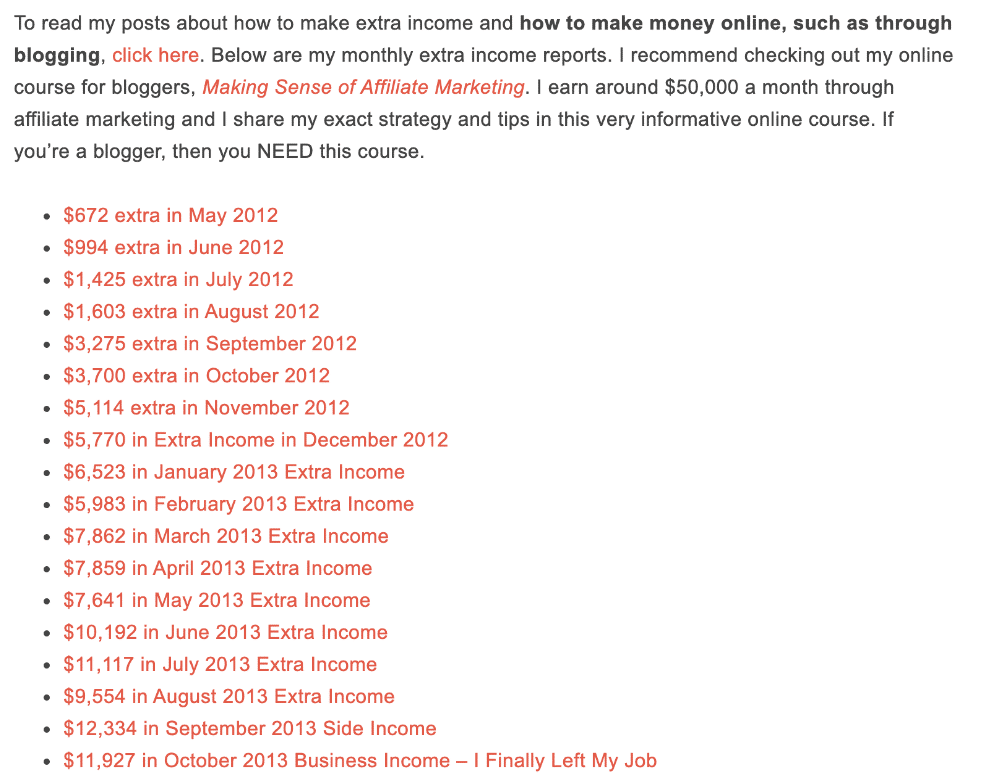
Recommendation: Here’s The Best Alternative
What’s Inside Making Sense of Affiliate Marketing?
Affiliate marketing can be a lucrative way to earn money through your blog or website, and “Making Sense of Affiliate Marketing” is a comprehensive course that can teach you everything you need to know to get started.
This course is written in an easy-to-follow format and includes workbooks, exercises, and strategies for creating a successful affiliate marketing plan.
The course is divided into six modules, each covering a different aspect of affiliate marketing. Here’s what you can expect from each module:
Module 1: What Is Affiliate Marketing?
This module provides an overview of affiliate marketing, including why and how companies have affiliate programs. You’ll learn the basics of how to get started with affiliate marketing.
Module 2: How To Find and Apply To Affiliate Programs
This module will teach you how to find affiliate programs and select the right products to promote. You’ll also learn how to apply to affiliate programs and get approved.
Module 3: Follow The Rules
The FTC requires affiliate posts to include a legal disclosure statement. This module will cover the disclosures you need to include to comply with FTC regulations.
Module 4: How To Get Your Readers To Convert
This section will teach you how to get your readers to click on your affiliate links and make purchases. You’ll learn how to create content that converts and build trust with your audience.
Module 5: Strategies and Ways To Promote Affiliate Links
In this module, you’ll learn the best ways to promote your affiliate products and increase your chances of earning commissions. You’ll also learn how to use social media, email marketing, and other tactics to promote your affiliate links.
Module 6: Rinse and Repeat
This module will teach you how to maintain an affiliate marketing strategy for long-term success. You’ll receive a checklist in this section for maintaining your affiliate strategies.
Bonus Materials
In addition to the modules, the course includes several workbooks, checklists, and bonus materials to help you succeed. Here are some of the bonus materials you’ll receive:
- How To Always Get Approved for Affiliate Programs
- How To Drive Thousands of Visitors To Your Blog with Pinterest (Video)
- 9 Things You Must Do When Something Goes Viral
- How To Increase Your Page Views
- Affiliate Products and Services (Worksheet)
- The Perfect Affiliate Link Checklist
- How To Maximize Your Reach, Your Impact, and Your Revenue with Facebook Ads
- Editing and Writing Strategies That Will Take Your Content To the Next Level
- How To Legally Protect Your Blog (Video)
Are Students of This Course Getting Results?
Despite the growing popularity of Making Sense of Affiliate Marketing, there seems to be a lack of success stories from its students. Although there are only eight testimonials on the course sales page, only a few of them reveal specific results achieved, while others offer general praise for Michelle, the creator of the course.
It’s worth noting that the first testimonial dates back to 2017, and the author credits her blogging success to a different course elsewhere.



Even more telling are the comments in the weekly “Winning Wednesday” posts on the MSoAM Facebook group, where only a few students report significant income earned from affiliate marketing.
With about 250 new students joining the course every six weeks, one would expect to see more success stories posted online. However, there is a surprising lack of criticism of the course material and few requests for refunds.
Could it be that Michelle’s likeable personality prevents students from criticizing her course? Or maybe the massive success Michelle has achieved as an affiliate marketer leads students to assume they are at fault when her training doesn’t work for them, so they are less inclined to ask for a refund.
How Much Does Making Sense of Affiliate Marketing Cost?
At $197, the course may be considered expensive for some, especially for those just starting out in affiliate marketing.
If you’re looking for a discount or coupon code, you’re not alone.
Unfortunately, there isn’t a regular or scheduled promotion available at this time. However, in the past, Michelle has offered up to 20% off the course for a limited time, so it’s worth keeping an eye out for future announcements.
It’s important to note that while the course itself may be a one-time payment, there may be additional costs that aren’t mentioned on the sales page.
Michelle may recommend purchasing other products or services to enhance your affiliate marketing experience, so keep this in mind when budgeting for the course.

Refund Policy
Making Sense of Affiliate Marketing offers a 30-day money-back guarantee that’s easy to obtain, as long as you can show that you’ve given the course a fair shot.
Now, we know what you’re thinking: “Conditional refunds? No, thank you!” But wait, before you click away, hear us out! We’ve heard from satisfied customers who’ve received full refunds without any trouble. In fact, one reviewer even received a refund after sending in a draft of their review along with the refund request!
So, how do you get that refund? Simply shoot an email to [email protected] and provide proof that you’ve completed the course and taken action on what you’ve learned.


Recommendation: Here’s The Best Alternative
Praise For Making Sense Of Affiliate Marketing
1. Supportive Community
Once you join the course, you’ll gain access to an active and supportive community of aspiring affiliate marketers. With quick responses and frequent posts from Michelle, you can get your questions answered in no time.
While the majority of members may be new to affiliate marketing, the group provides a great platform to connect with like-minded individuals. Michelle also takes time to interact with members, offering specific feedback and advice.
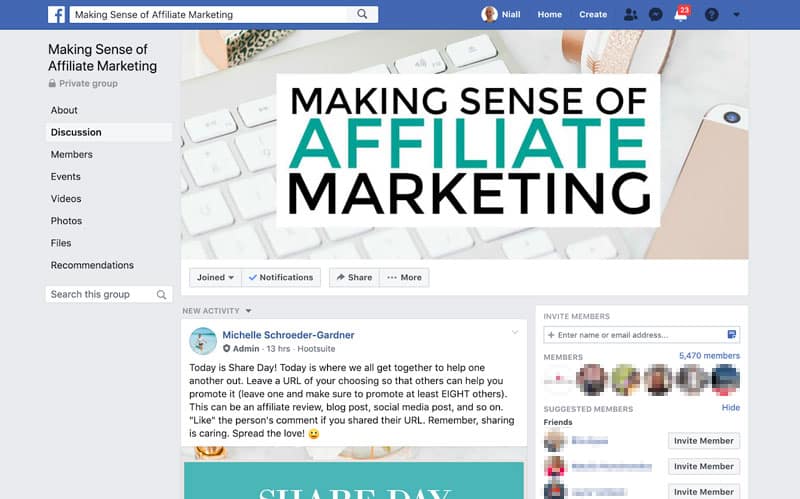
2. White Hat
Michelle emphasizes the importance of an honest and ethical approach to affiliate marketing. From requirements and disclosures to nofollowing links, the course covers all the basics.
This sets it apart from other courses, like Super Affiliate System, that may promote questionable practices.



3. Lifetime Access, Free Updates
When you invest in Making Sense of Affiliate Marketing, you’ll get lifetime access to all the course materials, the private community, and future updates. There are no recurring payments to worry about.
4. Bonus Lessons
The course offers two bonus lessons from guest coaches about Pinterest and Facebook Ads. These lessons stand out because they provide real, visual examples and engaging video formats.
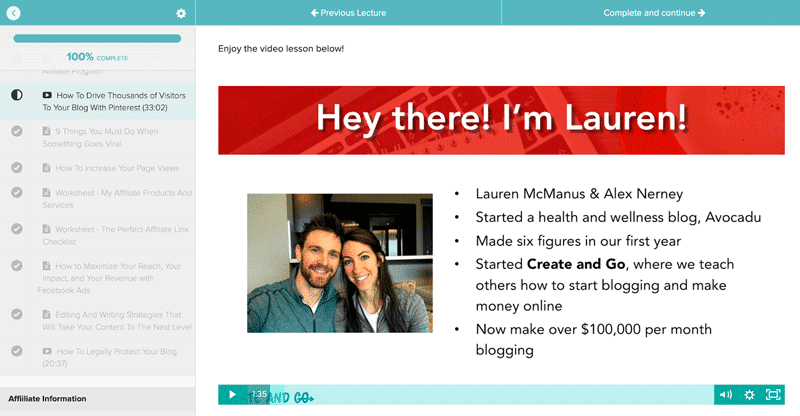
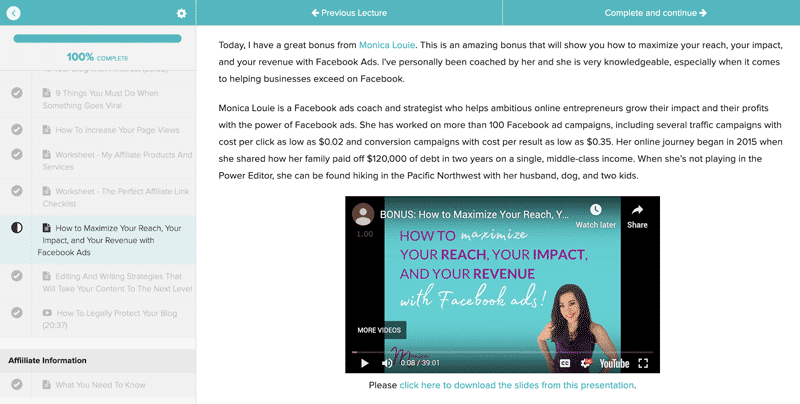
Criticism of Making Sense of Affiliate Marketing
1. The Good Reviews are Written by Michelle’s Affiliates
You probably have found some other reviews of Making Sense of Affiliate Marketing and most of them are saying good words.
Those bloggers, however, actually receive a large commission if you purchase Making Sense of Affiliate Marketing using their links. Therefore, their words are often biased and not trustworthy.
The reviews are merely sales pages that do not inform you about the hidden costs or the difficulty of making money using Michelle’s strategies.
When you search Making Sense of Affiliate Marketing review, you might see a website called
The Savvy Couple ranking the first page on Google:

Be careful! They are the super affiliate of Making Sense of Affiliate Marketing, meaning they make thousands of affiliate commissions by promoting Making Sense of Affiliate Marketing.
The 9/10 rating is just a sales tactic. Should you trust someone who has a conflict of interest and receives huge compensation to “review” a course? No, probably not. It’s not a review, it’s a sale!
Therefore, I recommend reading the reviews of those written by the non-affiliates of Making Sense of Affiliate Marketing.
I tried to search for the real user reviews of Making Sense of Affiliate Marketing on Trustpilot, which is the most credible review site:
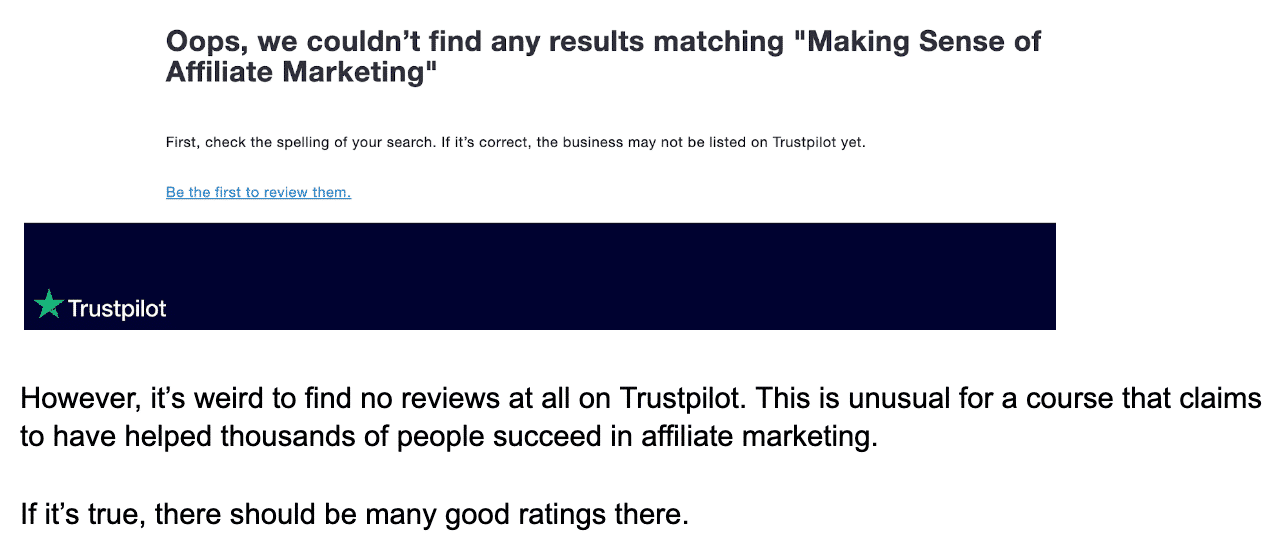
However, it’s weird to find no reviews at all on Trustpilot. This is unusual for a course that claims to have helped thousands of people succeed in affiliate marketing.
If it’s true, there should be many good ratings there.
2. The Training is Too Shallow and Generic
Despite making claims to be a “step-by-step affiliate marketing course,” the course lacks depth and specifics. Almost every topic the course covers can be found on the web for free.
It is perhaps best illustrated through Michelle’s lesson titled, “Teaching With Tutorials.” As a result, the lesson is only 612 words long, without any screenshots.
The lesson from Michelle about creating reviews isn’t much better, with 1182 words and four screenshots.
Making Sense of Affiliate Marketing delivers the same value in every lesson.
Yes, Michelle at least has all of the information organized for you in one place.
But I lost confidence in the training so much that I often had to turn to Google for more detailed and current information.
3. Lack of Practical Examples
You’ll find many claims and recommendations in Making Sense of Affiliate Marketing, but few citations or detailed instructions.
As an example, you are told to evaluate the management of each affiliate program you are interested in, but you are never shown how to do so.
You’re constantly told to “grow your list” and “track your progress,” but you’re never provided with any walk-throughs or instructions on how to do that.
There is also a note telling you that it’s important to “be an expert,” but that’s all the “instruction” you get on how to accomplish that.
Throughout the course, you will see many more examples of TELLING without SHOWING.
To learn affiliate marketing this way is like reading 100 pages of text plus 10 pictures to learn how to fly a plane.
4. No SEO Training
Its training on SEO is completely absent, unlike all other affiliate marketing courses I’ve seen.
According to statistics, Google is the top source of internet traffic in most industries, generating over half of it. Combined, Google drives 8 times as much traffic as all social networks.
Most top blogs receive 66.47 percent of their traffic from search engines, composed of 99.77% organic traffic and 0.23% paid traffic.
Therefore, in a course about affiliate marketing, you would expect to cover Search Engine Optimization (SEO).
However, I could only locate two mentions of SEO inside Making Sense of Affiliate Marketing:
Michelle admits she hasn’t relied on organic traffic to her website much, and this might be why this oversight has occurred:
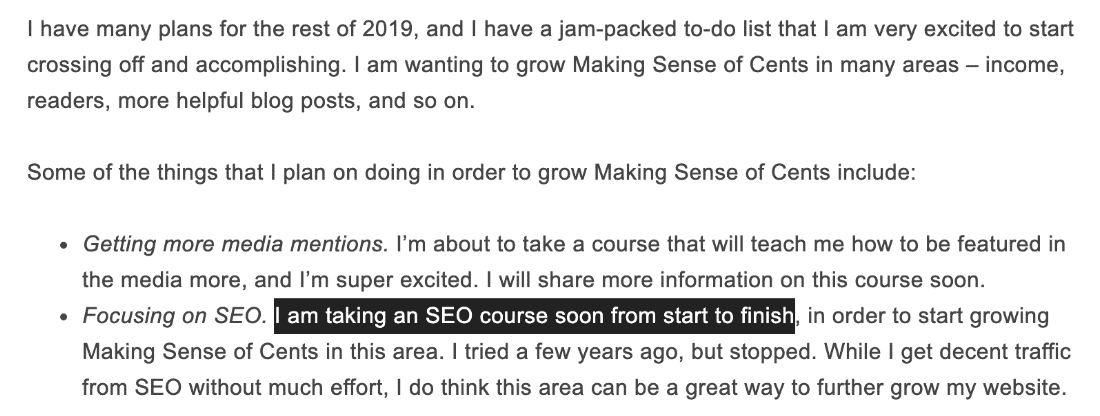
Only in 2019 did she start learning SEO. Do you think you’re comfortable learning affiliate marketing from someone who’s new to SEO?
The majority of traffic to blogs comes from SEO. Yet Michelle’s appears to be getting most of its traffic from social media, particularly Pinterest.
5. Almost All Text, Very Little Video
Video is used a lot in online courses these days for teaching material. However, most of Making Sense of Affiliate Marketing’s lessons are text-based.
This is more or less how most of the lessons look: walls of boring text with only a few screenshots to break up the monotony.
While not every topic would be better served by video, several undoubtedly would, such as:
- Google Analytics – Can you do a screencast showing where each of the important metrics can be found in the Google Analytics interface?
- Content Creation – An in-depth look at Michelle’s process of creating content would be amazing.
- Social Media Marketing – What if Michelle showed how she selects and schedules her social media updates on a screencast?
- Email Marketing – Michelle mentioned the importance of email marketing. It would have been great to see a screencast showing how she prepares and sends out an email.
As it is, Making Sense of Affiliate Marketing has only three video lessons, and none of them is from Michelle.
6. Lack of Successful Stories of Students
While Making Sense of Affiliate Marketing claims that a lot of their students see results from the training, there is no verified evidence to show this.
You may see some reviews posting screenshots from their Facebook group as proof of the success stories. But there is no way to verify if those are true results or not.
Also, some students who joined Making Sense of Affiliate Marketing are not beginners, and they already have a well-established website before joining.
So their results might not be attributed to the training of Making Sense of Affiliate Marketing. That means even if some do get results, it’s unlikely that you can do the same if you are a complete newbie.
8. Hidden Costs
The Making Sense of Affiliate Marketing sales page doesn’t mention any additional costs.
Once inside, you’ll see a number of recommended paid products and services, such as:
- ConvertKit – $29 per month (ConvertKit has a lot of alternatives. Mailchimp, for example, offers a free plan allowing you to email 2000 subscribers. In her student’s opinion, Michelle seems to be in a grey area of promoting what is profitable first and then if it is helpful to the reader.)
- Tailwind – $9.99 per month
- Facebook ads – $100+ a month (Michelle suggests spending $10 to $20 to boost a Facebook post. However, it is hard to make them work for affiliate products anymore.)
- Website Legal Templates – $100+ (In a webinar lesson, which is really just a sales pitch, it is recommended you buy a package of “website legal templates” that will cost you more than $100 even with the discount code.)
9. The Training is Not Suitable For Beginners
Whether you’re a new blogger or an experienced one, Making Sense of Affiliate Marketing promises to be helpful. However, the course isn’t particularly useful for beginners.
There is very little information in the course on how to drive traffic to a new blog. There is nothing about how to create a blog from scratch.
In fact, the entire course appears to assume that you have already established a blog with decent traffic, but you don’t know how to monetize it.
That’s the situation Michelle was in at the beginning of 2014. She was blogging for 3+ years, and her site was receiving 100,000 visitors every month.
However, she had no idea what affiliate marketing was, and wasn’t even earning $1000 per month from it.
You might be able to learn some helpful tips from Michelle’s course if you are in a similar position.
However, it’s certainly NOT the best way to learn how to blog, whether you are a novice or a pro.
10. Low-quality PDF Learning Materials
There are lots of PDF “worksheets” and bonus “lessons” in Making Sense of Affiliate Marketing. In addition to the mediocre content of the PDFs (at best), the format will have you scratching your head.
There are some PDFs that ask you to handwrite entire paragraphs, for no apparent reason.
Why these “worksheets” are not offered as Google Docs or Google Sheets that students can easily copy upload and edit themselves is beyond me.
There are some “bonuses” within Making Sense of Affiliate Marketing that is also offered as PDF files for no apparent reason.
I’m wondering why those “lessons” aren’t just linked to the course material as normal web pages.
I would guess that adding such thin content to a PDF makes it appear more substantial.
Recommendation: Here’s The Best Alternative
Is Making Sense of Affiliate Marketing a Scam? My Personal Experience…
Making Sense of Affiliate Marketing is not a scam. You can definitely learn something about affiliate marketing if you decide to invest in the course.
In fact, as an experienced affiliate marketer, I was eager to see if “Making Sense of Affiliate Marketing” could offer me new insights and strategies to boost my income. Michelle’s success story is well-known, and her course seemed promising.
However, after enrolling and going through the material, I found myself disappointed and questioning the effectiveness of her approach, particularly her heavy reliance on social media over SEO for promoting affiliate links.
While social media can be a powerful tool for engagement and community building, I believe it falls short when it comes to driving long-term, sustainable traffic and conversions compared to SEO.
SEO allows content to be discovered organically over time, providing a steady stream of visitors who are actively searching for information. In contrast, social media posts have a very short lifespan and require constant updates to maintain visibility. This makes it challenging to build a consistent and reliable income stream solely through social media.
However, Michelle doesn’t seem to care about your conversion rates other than her own commissions. Throughout the course, I noticed that many of the tools she suggested seemed to be chosen more for their affiliate programs than for their utility.
Bluehost is an example of this, as it has earned her the most affiliate income over the years. However, some members of the MSoAM Facebook group have complained about Bluehost’s services.
Worse still, the course content has not been significantly updated since its initial release in 2016. The digital marketing landscape is constantly evolving, and strategies that worked a few years ago may no longer be effective. The lack of updates means that the course fails to address current trends and best practices in affiliate marketing.
While Michelle covers the basics, she doesn’t delve into advanced strategies or provide detailed, actionable steps for scaling an affiliate business. For someone with prior experience, the content felt overly simplistic and repetitive, offering little in the way of new insights or techniques.
Though this course might be a decent starting point for complete beginners, I believe there are more comprehensive and up-to-date resources available for those serious about succeeding in affiliate marketing.
Is There A Better Alternative?
If you want to learn affiliate marketing in the right way, I’d recommend you to get started with the best training platform Wealthy Affiliate.
It offers you a free account (including a free website) with comprehensive training on SEO (free traffic methods) which enables you to get started with affiliate marketing right away without paying a penny.
But How Much Can You Earn with Wealthy Affiliate?
A 21-year old student from Wealthy Affiliate was able to earn $7,395 in just 1 week, which means he made more than $1k a day…all while using free traffic methods.
Where to Join Wealthy Affiliate?
Wealthy Affiliate has a very simple pricing scheme. It has free and premium membership.
If you want to feel about Wealthy Affiliate, you can sign up for the free starter membership here (no credit card required). You can select to be a free member with no time limit.
And as a starter member, you can get instant access to the community, live chat, over 500 training modules, 2 classrooms, networking, commenting, 1 free website, access to the keyword tool.

Jack Davis is an internet entrepreneur. He created the Affiliate Marketing Masterclass and offers personal coaching on affiliate marketing. He has been featured in major publications like Forbes, Entrepreneur, and CNBC for his achievements in online marketing. He owns more than 10 niche websites and has made millions of dollars from them. So, he’s the guy you can trust when it comes to building niche sites and SEO.
